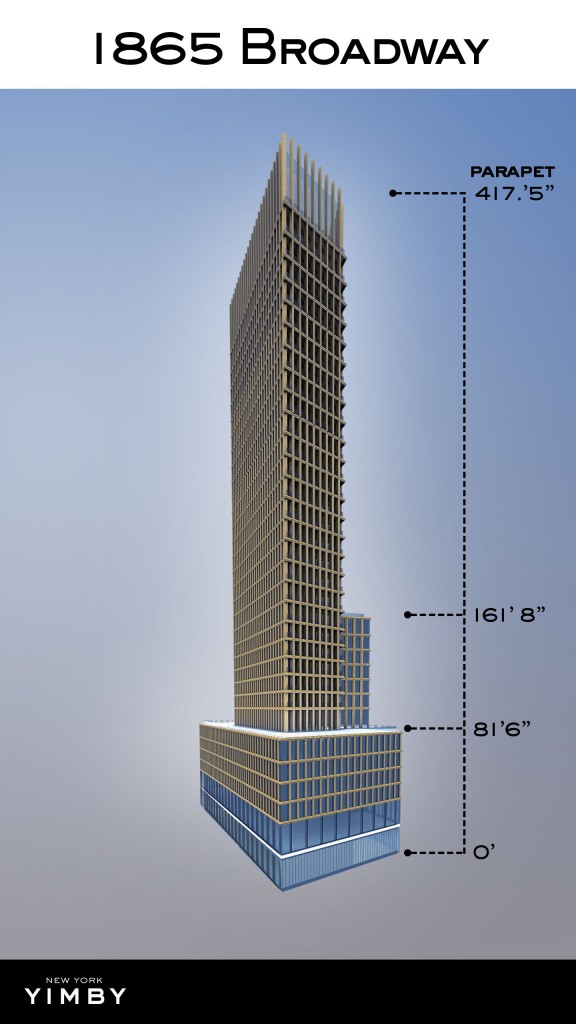Back in early 2014, YIMBY featured a first look at speculative plans for the redevelopment of the American Bible Society. That concept fell through, but we followed up with a post that included a prospective design by architects Goldstein Hill & West. Now, Skidmore Owings & Merrill has been tapped to design the project, and thanks to a tipster’s submission of diagrams for the project, we were able to create renderings that are a close approximation of what the building will ultimately look like.
AvalonBay Communities is developing the site, and the Wall Street Journal reported that they acquired the old building for $300 million back in February. The American Bible Society will move to Philadelphia, and its old headquarters will soon be torn down.
The location is one of the best in New York City, and while the site is not directly on Central Park, it’s immediately across the street from 15 Central Park West. Until the rise of 220 Central Park South — also located just two blocks southeast of 1865 Broadway — “Limestone Jesus” held the title of Manhattan’s most expensive residential building.
SOM’s plan for 1865 Broadway will complement its rival across the street quite nicely, employing a facade that evokes I.M. Pei’s Turtle Bay Towers, per our tipster. While YIMBY was able to secure construction diagrams, the renderings were not yet available, and our in-house expert Jose Hernandez modeled the building based on the schematics and advice from our tipster.
The plan features a major retail component at the base, totaling four floors, with two sub-levels and two above-ground levels of space. That will be topped by an angled setback that will include rental units. Above that, the actual tower portion begins, and in an unusual move for AvalonBay, that part will house condominiums from the 23rd floor on up.
Current plans indicate a mix of 131 rentals, ranging from alcove studios to a few four-bedrooms, while there will be 26 condos, all either two or three bedrooms besides a 4,000-square-foot four-bedroom unit on the penthouse level. The building’s gross size will measure 343,000 square feet, and the retail will measure almost 70,000 square feet.
1865 Broadway will stand 32 stories in all, with a parapet rising 417.5 feet above street level. While the height is demure by typical Manhattan standards, the surrounding neighborhood is short enough that the building will have relative prominence, especially when viewed from up or down Broadway.
Luckily, SOM’s plans are extremely appealing, and depart significantly from the firm’s glassier work just a few blocks south, at 250 West 55th Street. The width of the spandrels between the windows will decrease as the facade rises, and the end result will be a tapered execution in concrete elegance.
Like 432 Park Avenue, it appears that windows will be both single-pane and enormous. The single-pane aspect is the more expensive part of the equation, but with buyers willing to pay insane premiums for units at projects like 432 Park, the trade-off is justified for the super-high-end residential market.
Fittingly, SOM was also the architect of the old building that will be demolished to make way for the new tower. It was originally built in 1965, and while it offered a relatively tasteful addition to the Broadway streetscape, the new skyscraper will still be within the scale of the rest of the neighborhood’s recent developments, while also improving dramatically on both the old design, and the site’s accessibility to pedestrians.
The area’s transformation and the birth of the “Lincoln Square” moniker began with the razing of the old New York Coliseum, which gradually became a decrepit magnet for the city’s homeless until its demolition in 2000. Since the construction of Time Warner Center, adjacent blocks have experienced a real estate boom, and both Broadway and Columbus Circle have become some of the best examples of New York’s pedestrian renaissance.
Besides the rise of 15 Central Park West, Fordham Lincoln Center’s campus expansion has also been ongoing for the past several years, located on the super-block between Columbus and Amsterdam Avenues. Two residential towers have already been developed by Glenwood on the western edge of the site, and a new law school and dormitory has opened on 62nd Street. And soon, they will be joined by additional buildings fronting Columbus Avenue, which promise to fully integrate the campus into its Lincoln Square surrounds.
As for 1865 Broadway, no firm completion date has been announced, but demolition of the old building is set to begin shortly.
Subscribe to YIMBY’s daily e-mail
Follow YIMBYgram for real-time photo updates
Like YIMBY on Facebook
Follow YIMBY’s Twitter for the latest in YIMBYnews








What a boring, uninspired design. The old one was much better. This is disappointing coming from SOM.
Apple now has Rhapsody as an app, which is a great start, but it is currently hampered by the inability to store locally on your iPod, and has a dismal 64kbps bit rate. If this changes, then it will somewhat negate this advantage for the Zune, but the 10 songs per month will still be a big plus in Zune Pass’ favor.
This is getting a bit more subjective, but I much prefer the Zune Marketplace. The interface is colorful, has more flair, and some cool features like ‘Mixview’ that let you quickly see related albums, songs, or other users related to what you’re listening to. Clicking on one of those will center on that item, and another set of “neighbors” will come into view, allowing you to navigate around exploring by similar artists, songs, or users. Speaking of users, the Zune “Social” is also great fun, letting you find others with shared tastes and becoming friends with them. You then can listen to a playlist created based on an amalgamation of what all your friends are listening to, which is also enjoyable. Those concerned with privacy will be relieved to know you can prevent the public from seeing your personal listening habits if you so choose.
Between me and my husband we’ve owned more MP3 players over the years than I can count, including Sansas, iRivers, iPods (classic & touch), the Ibiza Rhapsody, etc. But, the last few years I’ve settled down to one line of players. Why? Because I was happy to discover how well-designed and fun to use the underappreciated (and widely mocked) Zunes are.
Apple now has Rhapsody as an app, which is a great start, but it is currently hampered by the inability to store locally on your iPod, and has a dismal 64kbps bit rate. If this changes, then it will somewhat negate this advantage for the Zune, but the 10 songs per month will still be a big plus in Zune Pass’ favor.
I’ll gear this review to 2 types of people: current Zune owners who are considering an upgrade, and people trying to decide between a Zune and an iPod. (There are other players worth considering out there, like the Sony Walkman X, but I hope this gives you enough info to make an informed decision of the Zune vs players other than the iPod line as well.)
This is getting a bit more subjective, but I much prefer the Zune Marketplace. The interface is colorful, has more flair, and some cool features like ‘Mixview’ that let you quickly see related albums, songs, or other users related to what you’re listening to. Clicking on one of those will center on that item, and another set of “neighbors” will come into view, allowing you to navigate around exploring by similar artists, songs, or users. Speaking of users, the Zune “Social” is also great fun, letting you find others with shared tastes and becoming friends with them. You then can listen to a playlist created based on an amalgamation of what all your friends are listening to, which is also enjoyable. Those concerned with privacy will be relieved to know you can prevent the public from seeing your personal listening habits if you so choose.
The Zune concentrates on being a Portable Media Player. Not a web browser. Not a game machine. Maybe in the future it’ll do even better in those areas, but for now it’s a fantastic way to organize and listen to your music and videos, and is without peer in that regard. The iPod’s strengths are its web browsing and apps. If those sound more compelling, perhaps it is your best choice.
Hands down, Apple’s app store wins by a mile. It’s a huge selection of all sorts of apps vs a rather sad selection of a handful for Zune. Microsoft has plans, especially in the realm of games, but I’m not sure I’d want to bet on the future if this aspect is important to you. The iPod is a much better choice in that case.